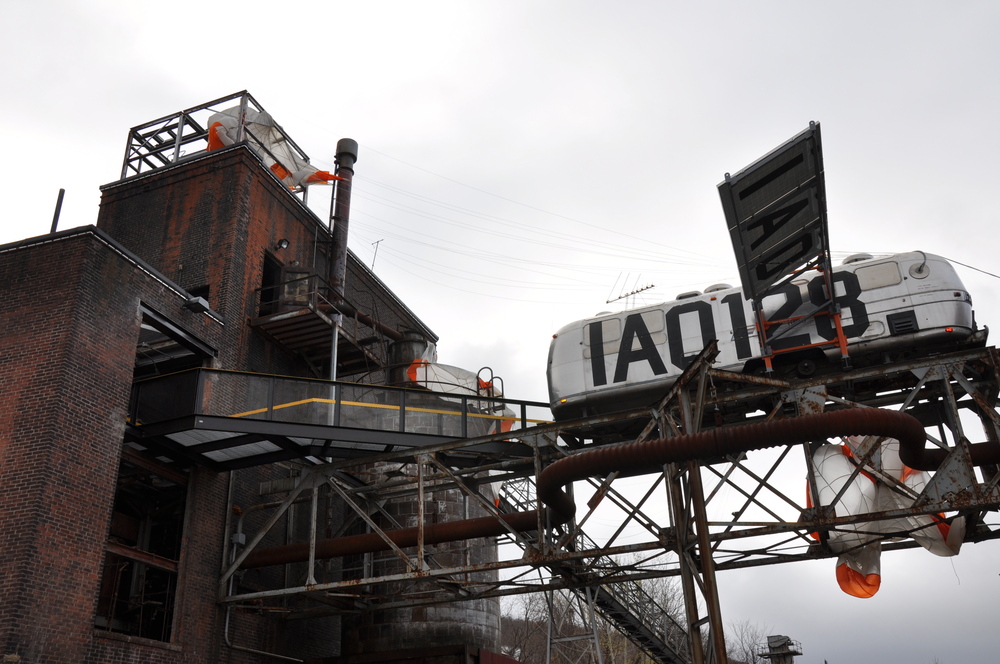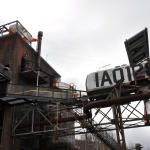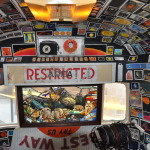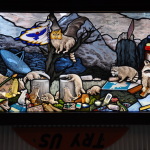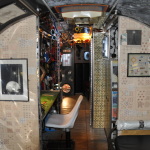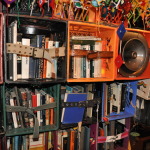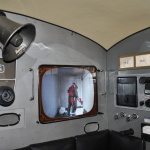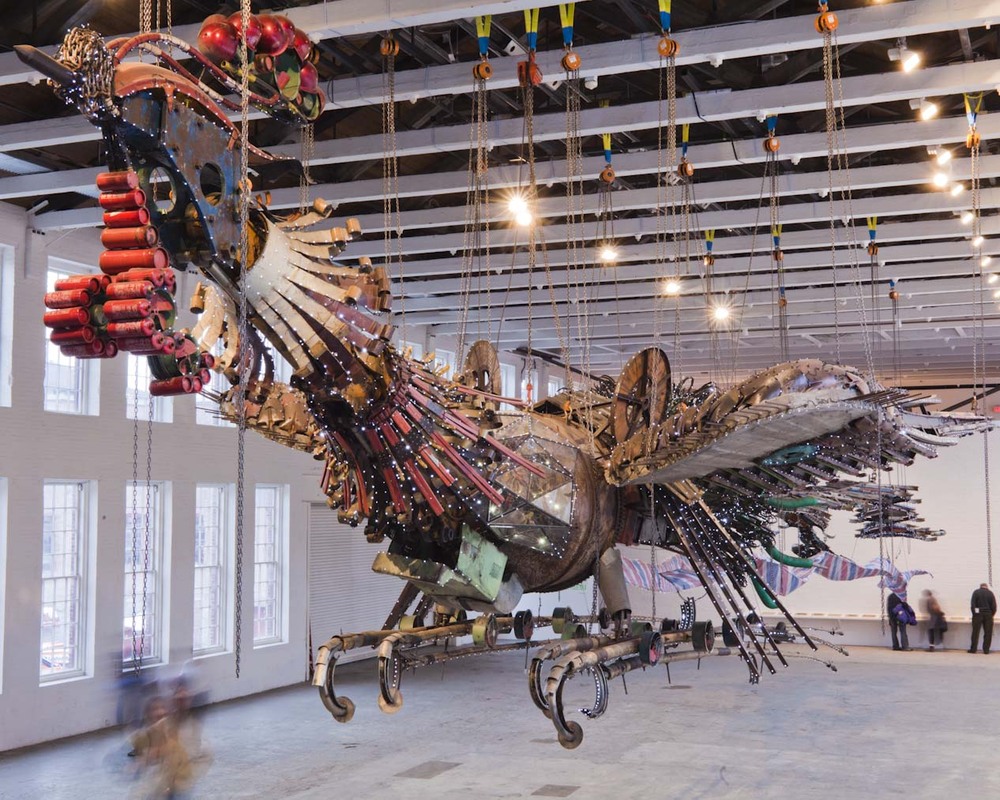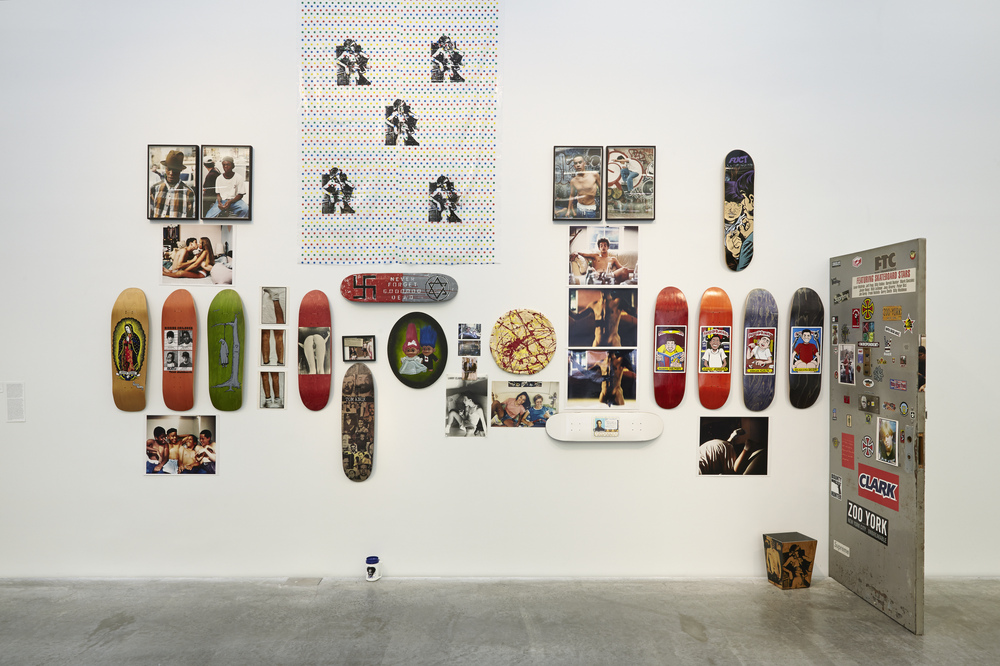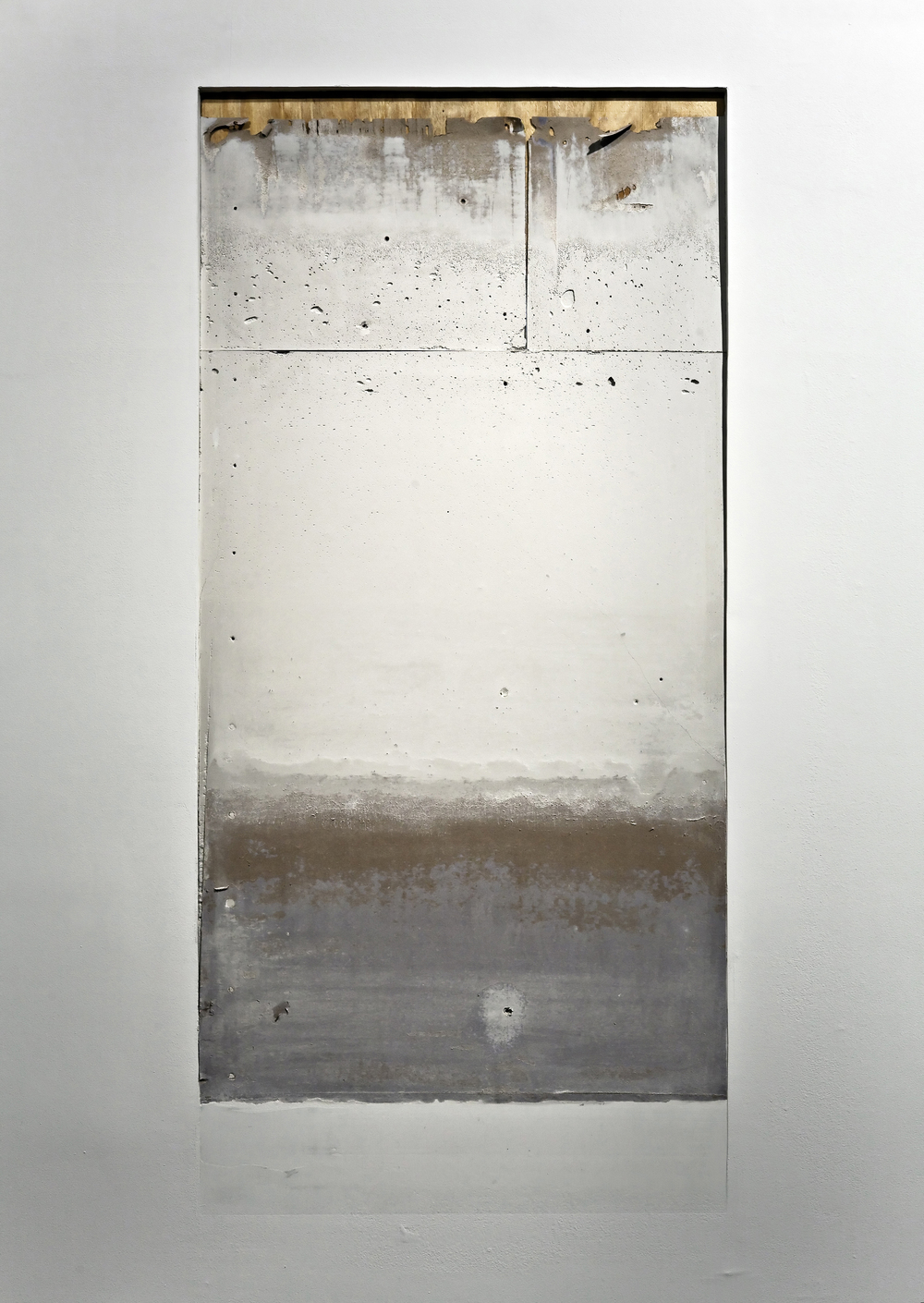The cultural resonance of Carusi’s sun ship runs deep, with associations diving into the distant past through stories we know all too well: the Egyptian image of the solar barque depicting a sun god travelling across the sky in a boat; the Grecian myth of Icarus, a cautionary tale of flight and ambition; the striving of Prometheus, whose gift of fire to man made him figurehead of western positivism. And then there are those examples from the recent past of individuals who have sought to use lived experience as a plastic material—like Marcel Duchamp, Joseph Beuys, Ray Johnson, and Bas Jan Ader. Often these stories are followed by attempts to uncover whether the fabled events actually took place, delaying the inevitable conclusion that the truth of the matter is simply beside the point.
What then to make out of this fallen dream? Is there an implicit critique in this gesture of the late-capitalist world in which he found himself? And what do we learn from the fact that Carusi never arrived at his fiery destination? What struck me, that sweltering day beyond the magnitude of Carusi’s effort to produce this Icarian craft, was his compulsion to create this elaborate image, to exceed the boundaries of his own life, and fashion it in the material of myth. In spite of his reclusive tendencies, there is a sense that Carusi wants to be found out, for his painstaking research to be appreciated, and his unrelenting obsession with heat, with power, to be felt.
Emily Zimmerman Could we begin by talking about how this airstream trailer came to be at MASS MoCA?
Michael Oatman
First Emily, I’d like to thank you for agreeing to preserve Carusi’s story, as detailed in the original 2011 interview. But a lot of time has passed, many people have seen "all utopias fell," and I can now speak ALSO about the project I made, not just the legend I uncovered. For the duration of this text, the interview will be augmented by texts like this in bold.
The project began in 2005 as an invitation to make an artwork utilizing solar panels. The solution to the panels was to insert mirrors into the field, making a reference to the format of an ‘unsolved’ puzzle as seen on wheel of Fortune. The hidden text I chose is not my own, but relevant to the larger project. But the project was far from done—it needed a viewing context. Various failed design ideas led me to research Sprague Electric, MASS MoCA’s predecessor on the North Adams site. Some literal digging opened up a hole in the wall where we needed to install the electrical system to manage the grid. It also opened up a hole into the world of one Donald Carusi, former Sprague employee and hobbyist engineer.
People that knew Donald Carusi when he was at Sprague said that he was a guy who could make anything. Apparently he spent a lot of time by himself, and started working here in the late fifties and suddenly in ’78, he’s gone. What we found when we came in here, before the ship landed, were these crates that were in Building 5 when we were running the electrical lines for the field of solar panels—that was the first part of this project. While we were trying to figure out where the batteries and inverters and the electrical lines would terminate we came across these crates that were addressed to Carusi at a Florida location, and that is where we assume he moved. After doing a little digging we found that a Donald Carusi had died in 1978 in Florida. Witnesses said that he had been electrocuted trying to set up a special aerial television antenna.
When we uncrated these rolling consoles, and plugged them in, amazingly, they seemed to be working, and they were immediately communicating with the closed circuit TV systems here at MASS MoCA. Images began to come up on the screens, and we created a display of this stuff that we had found. It wasn’t quite like Howard Carter walking into King Tut’s tomb, but they were mysterious objects crated up for another life. Little by little the story of Carusi came to us. For instance, here you see some of his teachers from MIT—it is unclear whether he graduated or not. He worked at Sprague probably as an engineer, and he probably worked on the Gemini Project. At Sprague they made parts for the switch for the atomic bomb, and it is likely that he worked on that project. He obviously had a lifelong interest in NASA; this is his version of Skylab, the 1970’s orbiting laboratory that hosted both American astronauts and Soviet cosmonauts. All of the stuff in here, the monitors, the controls, the lights, all of the electrical systems are powered by the solar panels so everything in here is off the grid. We realized that it is generating more power than it uses, so we did eventually tie it back into the grid, right back into MASS MoCA, helping the meter to spin backwards.
EZ So these are all his personal belongings?
MO
I spent a great deal of time in character as Carusi and this helped me locate things that were his, not mine. For example, the four hundred plus books and one hundred records were acquired over many years and the contents shifted a lot. Also, as time has gone on, museum visitors have contributed their own books and records to his life story. I’m pleased to say that all the "additions" have been pre-1978 materials!
Yes, there are a lot of personal archives in here. There is this food supply of tomatoes, which seems pretty one dimensional in a way, but it maybe also says something about his character. The picture that emerges of Carusi is one of a guy who was a sun worshipper, a sun scientist, who wanted to be near the object of his affection. He builds this thing, this ship, to get himself there. But at the same time he kind of takes himself out of society, and in my mind he’s part of that long line of people, like Thoreau, who did this. There is the ingenious aspect of his character too, like Tycho Brahe, who convinces the Danish Government to spend a fifth of their annual budget on building his castle, or like St. Francis, someone who lived alone and was closer to nature than to other human beings.
There is not much known about Carusi; there is some imagery of him at the end of one of the videos, he makes a transmission and we hear his voice saying something that cycles over and over again, a ham radio message that he is sending out, trying to contact a person he had made contact with twenty years earlier. It’s unclear whether or not he ever met the guy; he’s trying to signal someone named Paul. And then there is the record collection and lots of personal photographs that one presumes are family members or friends. And there is a lot of stuff from Sprague. Its almost like he takes with him this time capsule of his employment at Sprague and of his time here.
EZ This window is incredibly intricate.
MO The window seems to be very different from anything else in here, and to my mind it’s maybe a bon voyage gift from a neighbor. But the truth is that you don’t know much more about him than I do, and I haven’t spent enough time in here yet to really go through all of it.
EZ And these books in the crates, I see works on Buckminster Fuller here?
MO
One of the first books I acquired on behalf of Carusi was "I Seem to Be a Verb", an epic length concrete poem by Fuller. Beautifully typeset, it is a classic of 1970’s early environmentalism—globalism, really—before it garnered a negative connotation. It is also one of the books represented in the stained glass window, executed with great precision and humor by Debora Coombs.
The books are all his, they come from his library and every book has his bookplate. We were curious about this bookplate and did a little research. It turns out this was the original logo for Apple Computers. What he did was he turned the day sky into a night sky. What is amazing is that this is (the founders of Apple Computers) thinking about Newton, but what he’s holding almost looks like an iPad. It’s actually a tablet, a writing tablet and the legend around the logo says, "Newton . . A mind forever voyaging through strange seas of thought . . . Alone." So that’s almost like an emblem for Carusi himself and so clearly he just appropriated that thing because he liked it and this is the way he identified his books. There is a physics book down here that says "From the library of Bernard Vonnegut," Kurt Vonnegut’s brother. He invented modern cloud seeding. Kurt Vonnegut got his start as a writer by penning press releases for his brother and Vonnegut’s fictional city of Ilium is Troy, NY, my city. There is something like 400 volumes here. Which raises the question, what do you take with you when you are going away forever?"
EZ If the intention was to never return, how did the ship end up here?
MO Well, it returned to the roost. He built it in North Adams. There is an interesting image over here that shows a proposal for the Mount Greylock Monument and next to it there is what looks like a rocket tube. As near as we can figure out, it looks like he launched the ship from the top of Mount Greylock and was perhaps working with some sophisticated guidance systems, but the ship lands back in the factory where he worked, and it didn’t take out a building or anything when it landed. The four parachutes are draped over the old power plant and over the river. There is a lot that we don’t know; there is a lot that we are guessing at. Some of the things had to be taken out of the ship because they were not preserved well or broken or dangerous and we’re debating if and when those things come back in. They might be important pieces to understanding his story, but we’re just not sure yet. Every time I come back here there is more stuff I discover. There is more food stashed away inside these cupboards and a lot of replacement parts. Clearly he was interested in NASA. We determined that there is nothing on here that is more recent than 1978, and there is a date outside on the ship, which is almost like an artist signing his work. It’s a 1973 Airstream trailer that interestingly coincides with an important NASA program, the Pioneer 10 spacecraft, which was the first attempt by human to envision contact with extraterrestrials through a government project. Three weeks before Pioneer 10 is launched to go explore Saturn and beyond, Carl Sagan calls up his friend Frank Drake at the Jet Propulsion Lab and says were about to miss an amazing opportunity for communication. And so he describes to his wife an image: she then draws a naked man raising his hand in greeting and next to him is a naked woman, and they are standing in front of a schematic of the Pioneer 10. This was etched into a gold plate and attached to the side of the spacecraft.
And there is an interesting coincidence—because clearly Carusi was interested in this project—and there is this emblem on the side of the trailer followed by the motto "Fearless of heat I go to eat the hot star." Playing around with these letters in the great seal of the state of Ohio and remixing them you get this saying—so this sign ends up being an anagram of that motto, and this appears also on the flight crew uniforms in some of the videos. They also have the ship’s serial number on the side. Not only was Carusi a fan of the space program but I think he was aping some of the conventions of it: the patches, the methods of working. We’ve determined that the uniforms are made out of the former awnings of the ship, so these were cut away from it when it was still a trailer and before it was turned into a ship. There is a certain optimism and fervor of being caught up in the space program. I think of putting that plaque on the side of the Pioneer 10 spacecraft as the most optimistic gesture of an institution in history: "Let’s try to send a message out, and a map to where we are."
[Beeping from a video]
EZ Is this the message where we hear Carusi’s voice?
MO Yes. The only time we hear him we don’t see anything, and when we see him he doesn’t say anything.
EZ And these videos were on the ship when it was found?
MO: Yes, the images and the devices seem to be very consistent with the period of the ship. But sometimes you see absolutely contemporary images of suns from t-shirts, and car hoods, and tattoos. So its like this thing has some sort of scanning quality, and its showing stuff from the past and its showing stuff from the present.
Over here we see more videos that seem to operate at different moments in time. So you see on the monitors various catalogs of signs and other images that relate to the sun. You know, it’s just more obsession with the sun. On this monitor there is a kind of make out party after the workday.
EZ I heard recently that Benjamin Franklin never did the kite and key experiment, it was a myth. He understood that all of his inventions and that the contributions he had made to culture would not win him a place in history; in order to be remembered he needed to create an image that would transcend time. That almost seems to be what Carusi is doing here, except he has actually lived out his myth. It’s as if Benjamin had actually done the experiment, and it had failed.
MO If that is the camera lucida side of Benjamin Franklin, then his invention of the Busybodies in Philadelphia is the camera obscura.
EZ What are Busybodies?
MO There are houses in Philadelphia that still have them, it’s a mounted mirror on the second floor that lets you look into the mirror and see who is at your front door without them seeing you. I like that it is a real constructed device to hide the viewer, and the key is a fabricated, non-physical myth that is meant to put an image forward. It’s a beautiful pairing of diversionary tactics. Sometimes these stories are not about clarity, they’re about the depth of a puzzle.
All images courtesy of Michael Oatman.
Michael Oatman calls his practice ‘the poetic interpretation of documents’. His collages and installations integrate thousands of found, modified and handmade components, including artifacts of material culture, painting, drawing, video, and food. These architectural ‘unvironments’ have been installed at museums, public spaces and private homes. His installations are ‘context-specific’, and demand from him a total immersion into physical location, sonic/haptic realms, local history and the personal stories of those he encounters while working. He has exhibited extensively in the US and abroad.
Oatman received his BFA from RISD, and his MFA from the University at Albany. He has taught at Harvard, UVM, The University at Albany, St. Michael’s College and Vermont College. He has been a visiting critic at RISD from 1986 to the present. Since 1999 he has been a faculty member in the School of Architecture at Renssealer. He is represented by Ellen Miller in Boston, MA; Lenore Grey in Providence, RI; Stremmel Gallery, in Reno NV; and Mayson Gallery in New York City. In 2003 he won the Nancy Graves Award, and in 2009 he was voted best artist in the Capital Region of the past 30 years, by the staff of Metroland Magazine.
- All images courtesy of Michael Oatman
- All images courtesy of Michael Oatman
- All images courtesy of Michael Oatman
- All images courtesy of Michael Oatman
- All images courtesy of Michael Oatman
- All images courtesy of Michael Oatman

